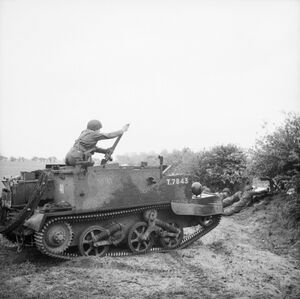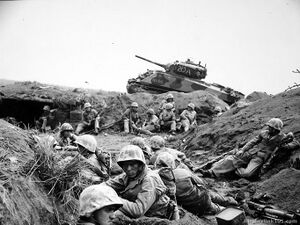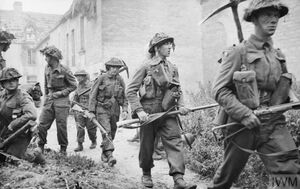Battle of Nabury
The Battle of Nabury was an early major battle of the Imperial Civil War in Vionna-Frankenlisch. An offensive by the Leftists from their base of power in southern Frankenlisch, led by Nigel Standhope, was made against Lopenfort. Nabury fell quickly on the 21st as it was defended by the local militia and elements of the Lopenfort Division. The Earl of Lopenfort, with forces of the Regular Army which mustered in Lopenfort on the 18th, sallied out against the Leftists and met their offensive head on with a counter-attack against Nabury. The counter-attack, headed by the King's Light Brigade, was costly yet succeeded in pushing back the offensive. Despite this initial victory, Standhope returned with reinforcements and fought again at the Battle of Shaffenstein.
Background
Leftist Attack
The Nabury Militia had assembled on the 18th along with the other militia units from the Barony at Nabury Town Hall for a muster by the Baron Nabury and forward elements of the reserve Lopenfort Division had also been positioned in the town as a precaution. All told there were about 800 Militiamen in Nabury along with 550 troops of the Lopenfort Division.
Nigel Standhope, who had been bestowed the rank of Marshal, assembled three divisions from the 200,000 men in the Brumley area and formed them into a force to invade the Lopenland which he perceived to be the weakest target in the area. Through this invasion, he also hoped to gain a land border with Belvania whom he hoped to purchase arms and equipment from. Marshal Standhope outfitted his men with the best equipment he could lay his hands on yet they still were almost entirely devoid of armoured vehicles. Nonetheless, he wanted to launch his offensive as early as possible, beginning it on the 17th of July. On the 19th the first Leftist units reached Nabury and, unchallenged thus far, entered the town.
Immediately they were met with a fusillade of gunfire from the surrounding buildings and they dug in on the outside of the town and were slowly reinforced by more and more of the offensive force. Slowly, over the course of two days, they pushed their way across the town. Fighting was close, building to building in the town centre with little heavy weaponry on either side. The rest of the Lopenfort Division set up in Shaffenstein to act as a place of retreat for the steadily losing garrison in Nabury. On the 21st, after about 400 casualties, the Imperial forces in Nabury pulled out under cover of night and began the retreat to Shaffenstein. When day broke, Marshal Standhope's men occupied the rest of the town.
Counterattack
More information: Operation Istimun
James Hamilton, the Baron Nabury, retreated to Lopenfort itself quickly by train and, now severely depressed from his defeat and perceived loss of honour, met with Lord Lopenfort. Hector Gallagher, the Earl of Lopenfort, immediately called in the local divisions of the regular army along with the local militia and the remains of the Lopenfort Division, all together this force numbered 90,000 and Gallagher (himself a commissioned Lieutenant General) took personal command. He planned an immediate counterattack dubbed Operation Istimun.
On the 23rd, the Imperial force which had been dubbed the Earl of Lopenfort's Corps, sallied out against the Leftists to turn back their offensive before they regained cohesion. The counter-attack was spearheaded by the King's Light Brigade which consisted of 200 tanks in three regiments: The 12th King's Royal Hussars, The Queen's Lancers and the Earl of Lopenfort's Hussars. Supported by the Royal Balion Brigade, consisting of volunteers from Balion, the Light Brigade began the attack on Nabury at midday on the 23rd.
The attack began promising for the Imperials as their armour was nigh invincible to the Leftist troops who suffered from a severe lack of heavy weapons and forces of the Queen's Lancers, supported by infantry from the Balion Brigade, retook Nabury Town Hall by 4:30pm. Marshal Standhope had about six thousand men in Nabury at the time and organised two divisions, the First and Second Rifle Divisions, of seven thousand men each and planned a pincer movement around Nabury to cut off Imperial forces within the town and form a defence to prevent any further Imperial advance. First Rifle Division met little resistance as it moved swiftly around to the west of Nabury and forward units reached the highway entering Nabury from the south where the advance stopped at 6:30pm.
The Second Rifle Division met with minor elements of the Earl of Lopenfort's Hussars who, with six Richmond tanks, held off the Leftists until mortars were brought up. The bombardment was mistaken for howitzers and the tanks withdrew into Nabury. Only infantry patrols challenged the division from then on and they met up with the First Rifle Division at the King's Highway just past 8pm. Standhope elected not to make any more movements on the 23rd and instead ordered his units to consolidate their positions as they had put the Imperials in a very precarious situation. Due to poor communication and reconnaissance, Lord Lopenfort and his staff were unaware of the encirclement until dawn the following day.
Lord Nabury's Headquarters, based at the General Post Office, was shelled by mortars in the early hours of the 24th and he immediately dispatched scouts to discover the source of the bombardment. A platoon under Lieutenant Lewis Downes eliminated a mortar battery located in the parking area of Nabury Hospital while another under Captain Walter Fitzgerald, a Balionic veteran of the Second Europan War, searched south of the GPO and ran straight into a rearguard company of the Leftist's Second Rifle Division. Pushed back with the loss of his machinegun team, Fitzgerald reported to Lord Nabury that Leftist troops were south of the town and he assumed, correctly, that they had been encircled. A breakdown in telephone communications and reliance on outdated radios meant that despite this report coming in at approximately 4:15am, news did not reach Lord Lopenfort in Shaffenstein until six or even later.
Breaking the Encirclement

Lord Lopenfort's headquarters in Shaffenstein was alerted to the encirclement at dawn but the general was still asleep and his staff decided not to wake him. Instead, combat patrols were sent out to make contact with the Leftist positions and to probe the enemy lines for weaknesses. It wasn't until 9am that Lord Lopenfort awoke and was informed of the situation. He immediately began forming together an assault group to break the encirclement and recalled the patrols to receive their reports. Two hundred men had been sent out and thirty casualties had been taken but the seemingly pointless exercise had actually made a very important gain. Thomas Smith, head of the Nabury Trade Unions Committee and an officer in the First Rifle Division had been captured. Under interrogation he informed the Imperial command on the displacement of his forces, indicating a very important weakpoint in the Leftist lines. Nabury Gaol, which was on the very edge of the town, had been ransacked during the encirclement and the prisoners had rioted and escaped. During this chaos, the building had suffered a flash fire and thus had been abandoned by its garrison of 350 men.
Trusting in Smith's testimony, Colonel Anthony Sandown and his 101st Infantry Regiment was ordered to spearhead the attack and was directed towards the prison. Joining the main attack was the 46th Infantry Regiment, three battalions of the Lopenfort Rifles and a battery of 33pdr howitzers. In reserve were 5,000 men of the Lopenfort Division and 20 tanks of the Queen's Lancers which were intended to exploit the gap Sandown was supposed to pierce in the Leftist lines. A young Lieutenant, William Camden of the 12th King's Royal Hussars, was ordered to join the first attack and in his Crusader tank to make his way swiftly to Lord Nabury with an order for all Imperial troops within Nabury to attack the positions of the Leftist First and Second Rifle Divisions. The attack was scheduled for that afternoon in the hopes that poor weather would prevail, helping to screen the assault.
At four in the afternoon the hot weather that had dominated the last week gave in and it began to rain. The sky became strewn with grey clouds. Under the cover of this overcast weather, Colonel Sandown was given the go-ahead to attack. His 101st Infantry Regiment and Colonel MacPherson's 46th Infantry Regiment moved quickly against Nabury Gaol which was noticeably blackened by the flash fire. Mounted in Universal Carriers, the Imperial troops reached the prison rapidly and advanced sections of the 101st Regiment seized the standing buildings. Captain George Manson set up the central building as a headquarters for the attacking force. No Leftist forces were encountered within the prison grounds.
The Leftist response was slow and made slower by shelling from howitzers which kept them pinned. Marshal Standhope was not aware of the Imperial breakthrough until two hours after Colonel Sandown had taken the prison. Once the 101st and 46th Infantry Regiments had seized the prison, the three battalions of the Lopenfort Rifles and the 20 Richmond tanks of the Queen's Lancers entered Nabury through the prison grounds, along with Lieutenant Camden's Crusader tank. Due to the poor radio communication, Camden had to drive to the General Post Office where Lord Nabury made his headquarters and delivered the order from Lord Lopenfort personally. The Lopenfort Rifles, once in the town, launched a coordinated attack against the Leftist First Rifle Division. Behind roadblocks, in buildings and entrenched in gardens and parks, the Leftists resisted tenaciously and had to be expelled point-by-point with artillery fire and bayonet charges. Despite their superiority in terms of artillery and tanks (the Queen's Lancers supported the attack), the Lopenfort Rifles took heavy casualties from both the dogged defenders and their own artillery which, due to poor communications, often overshot their targets.
However, in spite of casualties and facing hard opposition, the attack by the Lopenfort Rifles succeeded in opening an even wider gap in the Leftist lines. In fifty minutes of fighting, the Rifles sustained around eight hundred casualties out of three thousand combatants, including two colonels and four majors, leaving Colonel Colin Carrender of the 5th Battalion in command of the entire attacking force. At 8pm on the 24th, the fighting died down and Lord Lopenfort gave orders to break off action and made plans for the following morning.
The night passed relatively uneventfully, with both sides preferring to rest rather than strike during the darkness. Fresh troops were brought up to reinforce the two regiments at Nabury Gaol during the darkness of the early morning and men and trucks from the Royal Engineers were brought up to reinforce the Imperial position at the prison. They emplaced sandbags, barbed wire and machine gun nests while men of the 46th Infantry Regiment dug slit trenches. Leftist prisoners from the previous day's fighting were moved into Cell Block B of the prison which was not badly damaged in the chaos.


